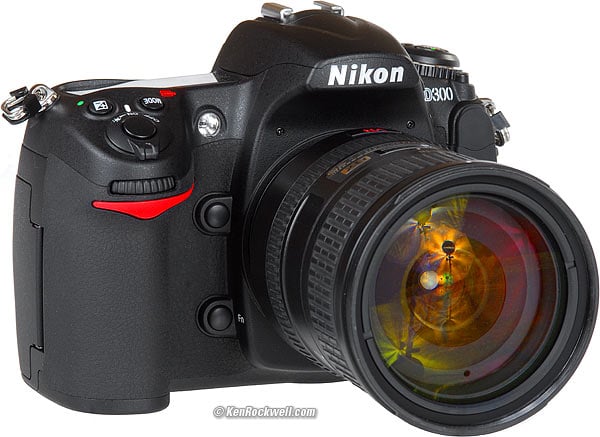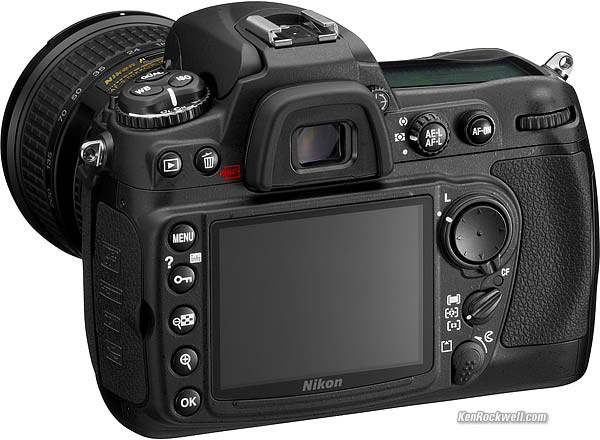Nikon
D300 Sales Features
© 2008 KenRockwell.com
Nikon D300. enlarge. I got mine from Ritz; Adorama, Amazon and B&H Photo Video are also great places. It helps me keep adding to this site when you use these links to get yours, thanks! Ken.
January 2008
Sales Features
These are what the the sales flyers push as exciting.
They aren't as important as what I discuss in my introduction and performance sections.
Recordable Color and Contrast Settings (examples)
Nikon uses the cryptic phrase "Picture Control System" to refer to the saturation and contrast adjustments. This keeps it as confusing as Canon's similar "Picture Styles" and "Parameters," which do the same thing.
Nikon claims that different model cameras set to the same settings will look the same, a great advantage for those of use with different cameras.
Canon has had a significant advantage because Canons have had a broader range of adjustments, so I can crank up my colors more vividly on my Canons than I can on my Nikons. Of course Nikon's narrower range of adjustments make it almost impossible to destroy your images by using the wrong settings, as I can do on my Canons.
My Nikons set to their maximum saturation (Color Mode IIIa and + Saturation in Optimize Image > Custom) are about equal to my Canons set at +2 saturation. My latest Canons go to +4 for saturation.
I'm unsure of the D300's performance here; it may be the same, but hopefully it's been expanded.
What has been expanded is a feature that's been in Casio point-and-shoots: the ability to store these settings and save, export and import them to and from cameras and users.
The Nikon D300 can customize and store up to nine sets of these, and export up to 99 to a CF card. Cooler still is that these settings can be shared with other new Nikon cameras, like the Nikon D3, after you've saved them.
Scene Recognition System
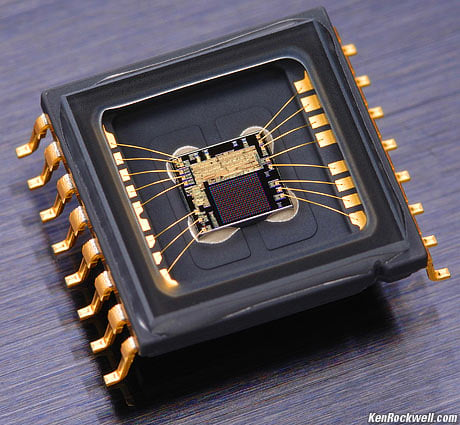
Nikon 1,005 Pixel RGB Sensor.
Nikon has used a unique 1,005-pixel RGB sensor for light meters in its top cameras since the Nikon F5 of 1998. Today this sensor's rough image is interpreted by the D300's computer to try to figure out what you are photographing, and based on this knowledge, adjust not only the exposure, but now also adjust the AF and white balance.
Proper exposure has always been predicated on knowing what you're photographing, and how then you want it to look. For instance, dark things need to be left dark, and light things need to be left bright. A brilliant orange dot in the frame might be the disc of the sun, or might be an orange. You need to know which to expose correctly. The 1,005 pixel sensor feeds its data to the computer, the computer makes a good guess about the subject, and then calculates the exposure. This is similar to the way our eyes see. Our eyes see little; they merely fed data to our brains in which all seeing occurs.
For example, 3D AF tracking locates a moving subject and automatically shifts AF points to track it. This system also tells the exposure computer the subject's location in the frame so it can be weighted accordingly. By knowing the distance, it's another way the computer can guess if it's the sun or an orange.
Like our eyes and brain, this system is far more than its hardware. What will make the Nikon D300 wonderful (or not) is how much genius and wisdom has been programmed into it by its creators.
This appears to be exactly the same as the Nikon D3.
HDMI Video Output
The Nikon D300 has a traditional analog NTSC and PAL video output. The D300's monitor works at the same time you use the analog output, but of course the analog video output looks crappy.
It also has a digital HDTV HDMI output, which plugs into most modern flat panel TVs and HDTVs. The only catch is that the D300's monitor goes blank when you use the HDMI output. The HDMI output runs at 1080i, as well as 480p and 720p, so it will drive any TV you're likely to encounter in the field.
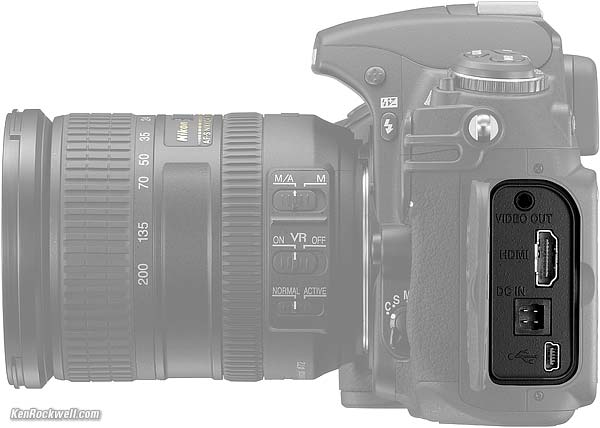
Nikon D300 Video, Data and Power Inputs and Outputs.
16-bit internals - so what?
That said, Nikon claims 14-bit ADCs and 16-bit internal processing pipes. Big deal; the proof is in how cleverly the designers utilize this power and precision. For instance, 16-bit CD players in the 1980s often used 32-bit internal precision in the guts of their the FIR filters, no big deal. It is customary in digital signal processing to use far more bits internally than any of the inputs or outputs so that one can maintain the precision of the input or output through all the nasty internal steps involved. It's been done this way for decades; in fact, to maintain 14 bits of precision one probably ought to use 24 or 32 bits internally.
More bits means the ability to split brightness levels in each RGB channel more ways. Each extra bit means we can split the same range into twice as many levels.
The number of bits has nothing to do with the range itself.
12 bits allows 4,096 shades in each color (R, G and B).
14 bits allows 16,384 shades in each.
16 bits allows 65,536 shades in each.
Our eyes only see 100 shades at best in each channel; even 8 bits is more than enough. 20 years ago when I made A/D and D/A converters for a living, we discovered we couldn't see more than 5 bits. LCD displays only work in 6 bits, inkjet printers only in 5! LCDs and inkjets make up for this with dithering.
The reason for more bits is marketing. If I stretched for an engineering reason, it is because these bits are used for linear capture, before the application of curves. In darker areas, more bits for the initial capture lets you stretch the curves a little bit more.
A/D converter pinout is just one tiny piece of a much larger design puzzle. Far more important is how well everything works together as a whole. That depends on the wisdom of the designers.
"EXPEED – Nikon’s image processing concept embodied." What?
16-bit internals is real technology understood by most engineers.
"EXPEED – Nikon’s image processing concept embodied" is just marketing fluff. It's Nikon's fluff for the fact that the insides of their digital cameras contain signal processing, as every digital camera and CD player has for decades. It's like Canon's DIGIC: meaningless to users.
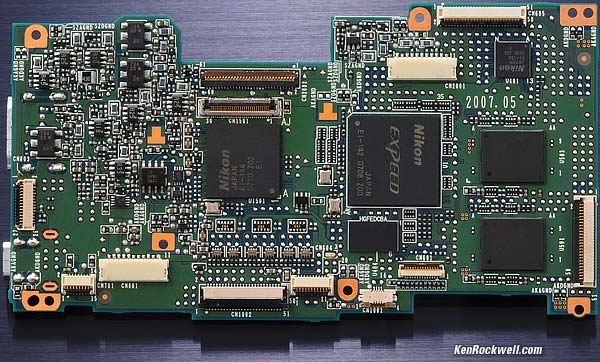
Nikon D300 Main Printed Circuit Board.
Body
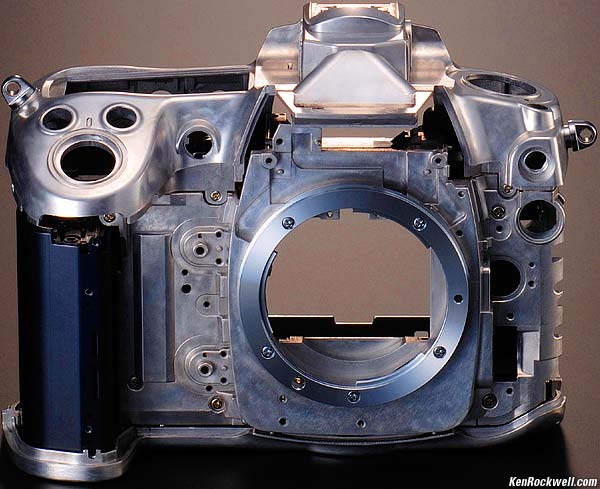
Nikon D300 Chassis
Magnesium alloy chassis with lots of seals and gaskets.
The rear LCD is strengthened with tempered glass.
Autofocus
51 points.
The center 15 sensors see detail in any orientation (cross sensors), while the other 36 sensors can only focus on details if they run in the correct direction (Nikon calls these horizontal sensors).
Multi-CAM 3500DX sensor and numerous selection modes few people will ever figure out. The good news is that my other Nikons always work great, even if no one really knows what's happening inside. I have no reason to believe that the AF of the D300 is anything other than spectacular; lets hope the finder isn't obliterated with AF sensors so we can compose clearly.
Very sensitive as most AF systems, rated down to EV -1.
In Live View Mode, the AF system has another completely separate system that can autofocus directly from the image gathered by the image sensor, as point-and-shoots do.
AF Illuminator: Yes.
Sensor
CMOS
Ultrasonic Sensor Cleaner.
Live-View 3" LCD Monitor
Nikon D300 enlarge
Three days after Canon introduced the Canon 40D with Live View around this price range, Nikon has outdone Canon because Nikon's AF system works two different ways while in Live View, while Canon's does not work at all. Canon requires you use a custom function and press a button to flip up the mirror and interrupt Live View to do a spot AF setting, while the Nikon D300's AF system works in Live view.
The Canon system has to take the camera out of Live View for a moment to autofocus.
I'll opine that the D300's AF mirror remains in place while the viewing mirror gets out of the way. If this is the case, that means that the AF mirror still needs to flip out of the way when you shoot in Live View with the D300.
But wait - it gets better! The D300 also can do live view with both mirrors out of the way, as does the autofocusless Canon 40D, but the Nikon, unlike the 40D, is smart enough to do AF using the image directly from the image sensor, like a point and shoot, which Canon can't do.
You may select the on-screen area on which to focus, too.
Color Playback Histogram: YES.
Live Histogram: no.
Back to Page Index of Nikon D300 Review
PLUG
If you find this as helpful as a book you might have had to buy or a workshop you may have had to take, feel free to help me continue helping everyone.
Thanks for reading!
Ken

